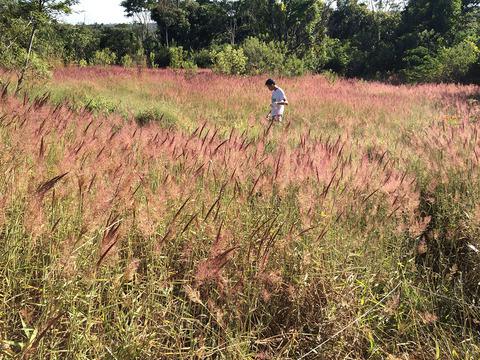当前位置:
X-MOL 学术
›
Funct. Ecol.
›
论文详情
Our official English website, www.x-mol.net, welcomes your
feedback! (Note: you will need to create a separate account there.)
Synergistic impacts of co‐occurring invasive grasses cause persistent effects in the soil‐plant system after selective removal
Functional Ecology ( IF 4.6 ) Pub Date : 2020-02-03 , DOI: 10.1111/1365-2435.13524 Rafael D. Zenni 1 , Wanderson L. Cunha 2 , Carolina Musso 3 , Jocemara V. Souza 3 , Gabriela B. Nardoto 2, 3 , Heloisa S. Miranda 2, 3
中文翻译:

共生入侵草的协同效应在选择性去除后对土壤-植物系统产生持续影响
更新日期:2020-02-03
Functional Ecology ( IF 4.6 ) Pub Date : 2020-02-03 , DOI: 10.1111/1365-2435.13524 Rafael D. Zenni 1 , Wanderson L. Cunha 2 , Carolina Musso 3 , Jocemara V. Souza 3 , Gabriela B. Nardoto 2, 3 , Heloisa S. Miranda 2, 3
Affiliation

|
- Human influence on the environment is so extensive that virtually all ecosystems on the planet are now affected by biological invasions. And, often, ecosystems are invaded by multiple co‐occurring non‐native species. Hence, it is important to understand the impacts these invasions are producing on biodiversity and ecosystem processes.
- Here, we present results of a 2‐year long field experiment where we tested the effects of co‐occurring invasive C4 African grasses in a Cerrado area in central Brazil. We compared plant and arthropod communities, plant biomass, and soil nitrogen dynamics and soil chemical characteristics across five experimental treatments: Urochloa decumbens removal; Melinis minutiflora removal; both U. decumbens and M. minutiflora removal; U. decumbens and M. minutiflora invaded plots; and uninvaded Cerrado. We hypothesized that selective removal of invasive grasses would have distinct effects on the native ecosystem structure and functioning. We expected that each invasive grass would produce a different type of impact on the native ecosystem and that their impacts would be synergistic when co‐occurring.
- Removal of M. minutiflora doubled native plant diversity and biomass when compared to invaded plots, whereas removal of U. decumbens did not alter these parameters. Cerrado plots had four times more plant species than plots cleared of invasives. Removal of invasive grasses did not affect the species richness or community composition of soil epigeal fauna. Cerrado soils had lower fertility, organic matter content and pH than invaded soils. The effects were generally higher when both invasive grasses were removed, suggesting impacts were synergistic, but M. minutiflora had greater effects on plants and soils than U. decumbens. Both invasive species produced negative impacts, but a single species was the main driver. We also detected persistent effects of the invasive grass species on the ecosystem after 2 years of removal.
- We conclude that invasive species of the same functional group have similar types of effects in native ecosystems, but the magnitude of impact was largely dependent on invasive species biomass and cover. Where multiple invasive species are present, research and management of invaded ecosystems should tackle the interacting effects of co‐occurring invaders.
中文翻译:

共生入侵草的协同效应在选择性去除后对土壤-植物系统产生持续影响
- 人类对环境的影响是如此广泛,以至于地球上几乎所有的生态系统现在都受到生物入侵的影响。而且,通常,生态系统被多种同时发生的非本地物种入侵。因此,重要的是要了解这些入侵对生物多样性和生态系统过程产生的影响。
- 在这里,我们介绍了一项为期2年的长期田间试验的结果,在该试验中,我们测试了巴西中部塞拉多地区同时发生的入侵性C 4非洲草的影响。我们比较了五个实验处理中的植物和节肢动物群落,植物生物量以及土壤氮动力学和土壤化学特征:去除了Uurchloa decumbens;去除Melinis minutiflora ; 既U. 斜卧和M. 糖蜜去除; U. decumbens和M. minutiflora入侵地块 和未入侵的塞拉多。我们假设有选择地去除入侵性的草会对原生生态系统的结构和功能产生明显的影响。我们预计,每一种入侵性草会对本地生态系统产生不同类型的影响,并且在共生时它们的影响将是协同的。
- 与入侵地块相比,去除M. minutiflora使本地植物多样性和生物量增加了一倍,而去除U. decumbens不会改变这些参数。塞拉多地块的植物种类是入侵清除区的四倍。去除侵入性草并没有影响土壤表皮动物的物种丰富度或群落组成。塞拉多土壤的肥力,有机质含量和pH值均低于入侵土壤。效果都当两个侵入草除去一般较高,这表明影响是协同作用,但是M. 糖蜜对植物和土壤更大作用比U. 斜卧。两种入侵物种都产生了负面影响,但单个物种是主要驱动力。去除2年后,我们还检测到入侵草种对生态系统的持续影响。
- 我们得出的结论是,同一功能组的入侵物种在原生生态系统中具有相似类型的影响,但影响的程度很大程度上取决于入侵物种的生物量和覆盖率。在存在多种入侵物种的地方,对入侵生态系统的研究和管理应解决同时发生的入侵者的相互作用。











































 京公网安备 11010802027423号
京公网安备 11010802027423号